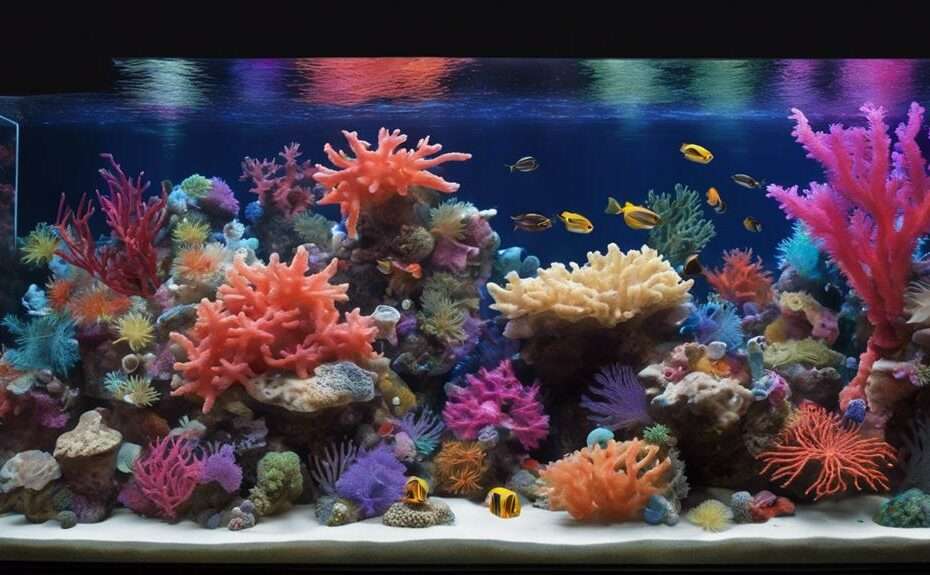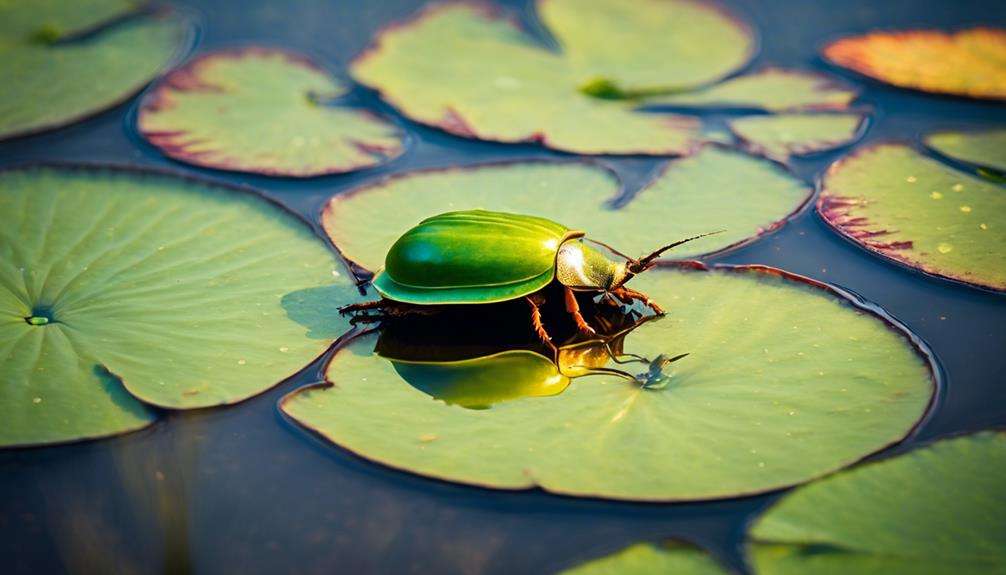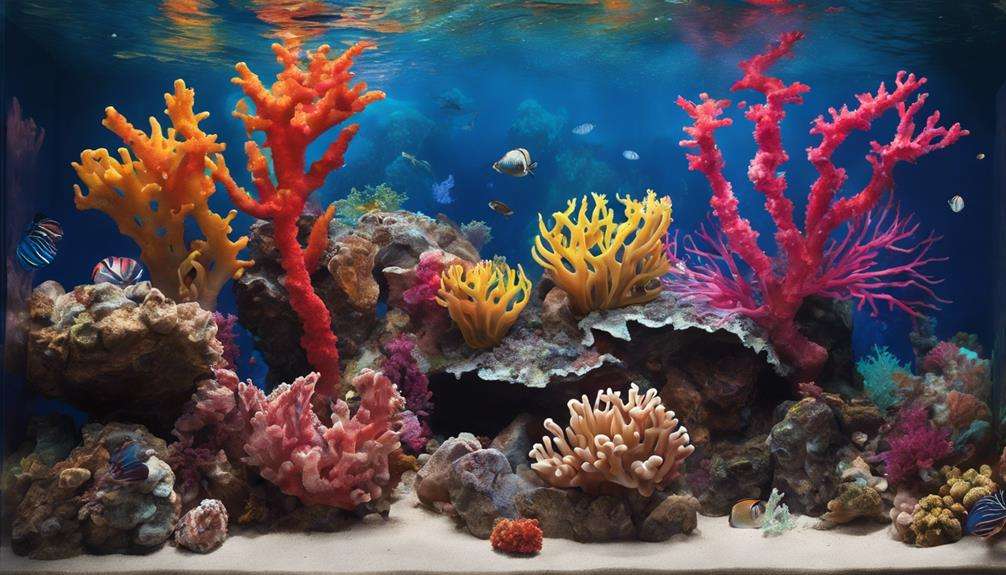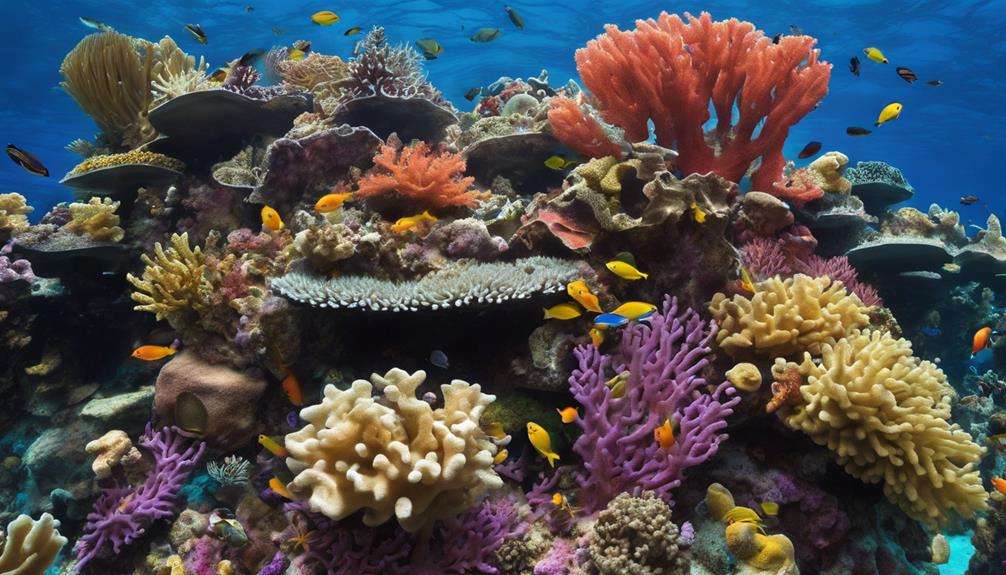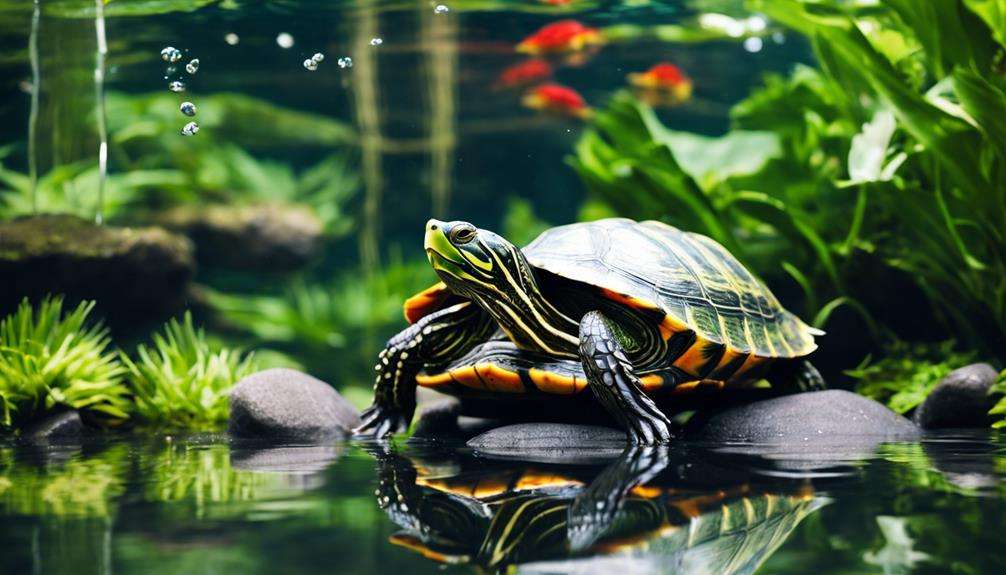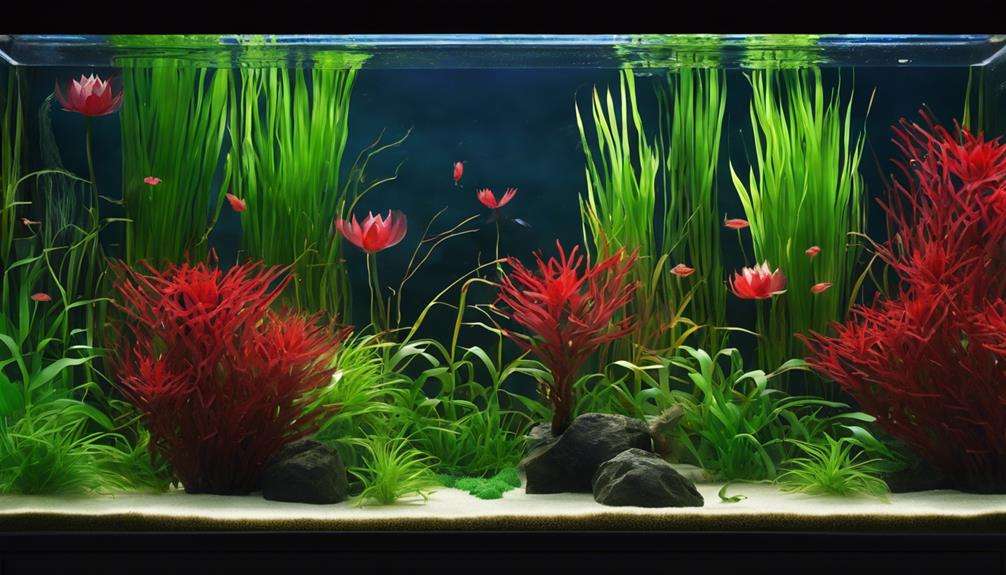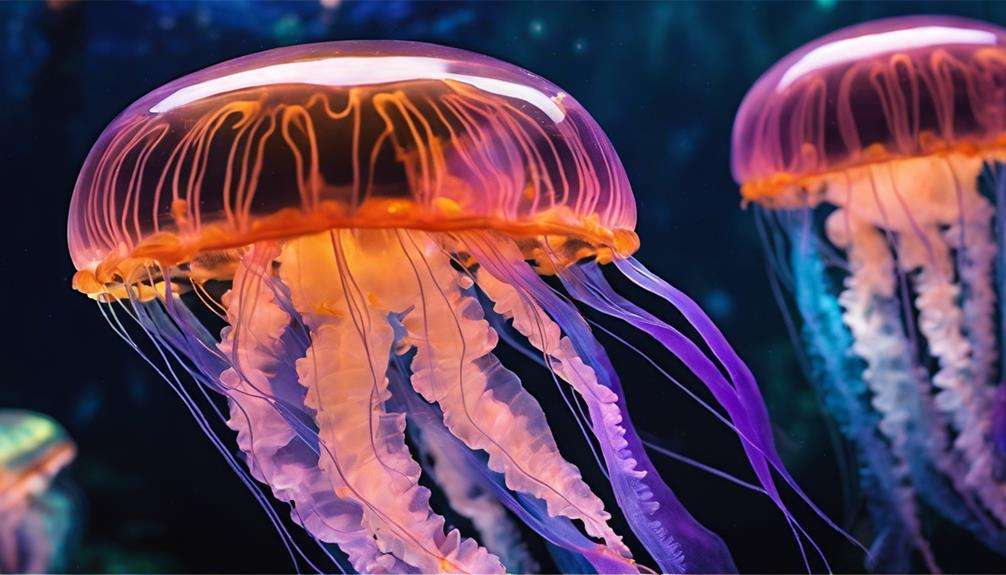Ever heard the saying, 'Don't judge a book by its cover'? Well, in the world of saltwater invertebrates, appearances can be deceiving.
As a pet owner, you may be intrigued by the allure of exotic marine species for your aquarium, but have you considered the unique challenges they bring?
Understanding the intricacies of caring for these alluring creatures goes beyond mere aesthetics. Dive deeper into the kingdom of saltwater invertebrates to uncover the secrets that lie beneath the surface and discover the rewarding journey that awaits you.
Key Takeaways
- Arrow Crabs and Coral Banded Shrimp are beneficial for pest control and tank cleanliness.
- Harlequin Shrimp and Feather Duster Worms require specialized care and diets in smaller tanks.
- Fire Urchins, Peppermint Shrimp, Sea Apples, and Chocolate Chip Starfish need varied diets and stable tank conditions.
- Harlequin Ghost Pipefish demand specific care and live food in controlled environments for experienced aquarists.
Fascinating Arrow Crabs
Arrow crabs, also referred to as spider crabs, captivate marine enthusiasts with their distinctive appearance and beneficial role in saltwater aquarium ecosystems. Over the past few years, the understanding of these intriguing creatures has greatly improved, providing much better and more detailed information for pet owners.
Arrow crabs can be a striking addition to your aquarium, with their long, thin legs and arrow-shaped bodies adding a unique touch to the underwater landscape. Their role in controlling pest populations within the tank, such as bristle worms and small snails, makes them valuable members of the aquatic community.
While generally peaceful towards larger tank mates, caution should be exercised as they may display aggression towards smaller crustaceans. To guarantee the well-being of arrow crabs in captivity, it's important to provide a well-established aquarium with ample hiding spots and a diverse diet consisting of meaty foods.
With proper care, these fascinating invertebrates can thrive and contribute to the health of your saltwater aquarium.
Vibrant Coral Banded Shrimp
Coral Banded Shrimp, scientifically known as Stenopus hispidus, are prized for their vivid coloration and engaging behavior in saltwater aquariums. Their distinctive red and white bands make them stand out, adding a visual spectacle to marine tanks.
While these invertebrates are generally low-maintenance and hardy, it's essential to contemplate their potential aggression towards other shrimp species or small fish when planning tank mates.
Colorful Shrimp Behavior
With their vibrant red and white bands, the behavior of the Coral Banded Shrimp in saltwater aquariums is characterized by active cleaning and unique antennae waving displays. These shrimp are diligent cleaners, enthusiastically removing parasites and debris from fish, contributing to the overall health of the aquarium ecosystem.
The waving of their antennae serves as a form of communication among individuals and can also indicate dominance within the group. This behavior adds an intriguing aspect to their presence in the tank, making them mesmerizing to observe.
While generally considered reef-safe, Coral Banded Shrimp may exhibit aggression towards other shrimp or small fish, so it's important to monitor their interactions. Their hardy nature and ease of care make them a popular choice for marine aquarium enthusiasts seeking colorful and engaging invertebrates.
Tank Compatibility Tips
For best tank compatibility with Vibrant Coral Banded Shrimp, consider providing ample hiding spots and space for establishing territories to minimize potential conflicts in a mixed species aquarium setting. When decorating the tank, incorporate live rock formations, caves, and other structures to create separate areas for each shrimp to claim as their own.
To manage aggression, avoid keeping multiple Coral Banded Shrimp together unless the tank is large enough to accommodate their territorial behavior. When selecting tank mates, choose peaceful fish species that are too large to be seen as prey by the shrimp.
Observing the shrimp's behavior regularly can help prevent any aggressive interactions and make a harmonious environment for all inhabitants in the aquarium.
Colorful Harlequin Shrimp
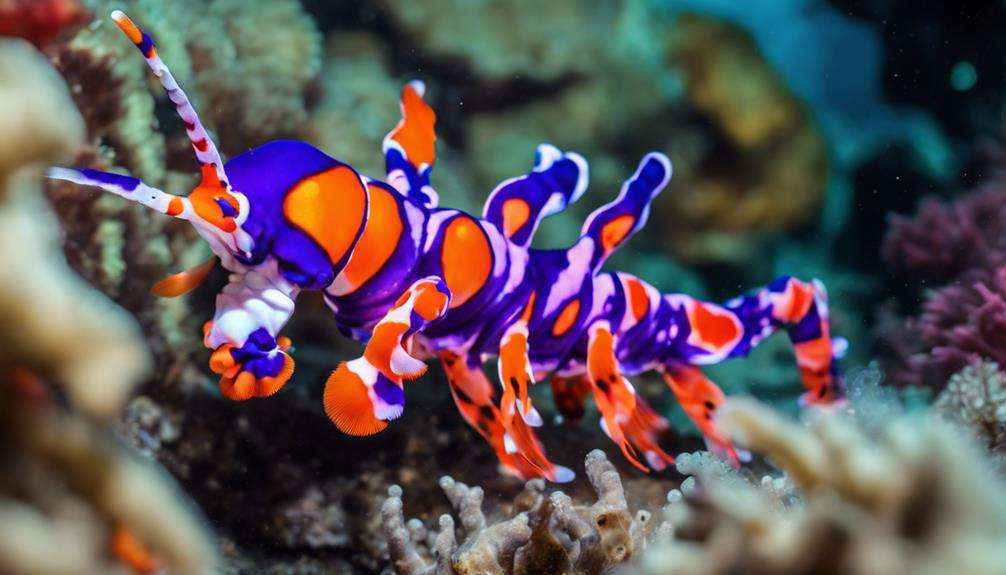
Colorful Harlequin Shrimp, with their vibrant hues and intricate patterns, captivate marine enthusiasts with their unique predatory behavior. These striking marine invertebrates exhibit fascinating breeding habits, with pairs forming monogamous relationships and engaging in intricate courtship rituals.
Harlequin Shrimp display color variations ranging from bright reds and oranges to deep purples and blues, adding a beautiful aesthetic to any saltwater aquarium. When it comes to feeding techniques, these specialized predators have a singular diet focused on starfish, particularly favoring the arms of sea stars.
To sustain these shrimp in captivity, providing a stable source of starfish is essential. Their small size, reaching about 2 inches, makes them suitable for smaller tanks with live rock. However, due to their specific dietary requirements, Harlequin Shrimp are best taken care of by experienced aquarists who can meet their nutritional needs for the best health and longevity.
Stunning Feather Duster Worms
Feather duster worms are fascinating marine creatures known for their vibrant colors and intricate feather-like tentacles.
These worms are filter feeders, relying on phytoplankton and small particles for sustenance.
In reef aquariums, they provide both aesthetic appeal and contribute to the ecosystem's balance through their feeding habits.
Feeding Feather Dusters
Filter-feeding marine worms, known as feather dusters, capture plankton and organic particles using their specialized feeding structures called radioles. These delicate creatures employ passive filter-feeding techniques, where they extend their radioles into the water to catch microscopic food particles.
Feather dusters have specific food preferences, requiring a diet rich in phytoplankton, zooplankton, and dissolved organic matter. Meeting their nutritional needs is vital for their survival and well-being in a marine aquarium setting. Providing a consistent source of these food sources is essential to guarantee the health and longevity of feather dusters.
Habitat for Worms
To provide an ideal habitat for stunning feather duster worms in your marine aquarium, it's essential to mimic their natural environment by creating suitable conditions that support their unique feeding and sheltering behaviors.
These segmented worms construct tubes using secreted mucus and sediment, preferring to anchor themselves in crevices or substrate within the aquarium. Feather duster worms are filter feeders, utilizing their feathery tentacles to capture tiny organisms and particles from the water column. They thrive in environments with moderate water flow to help bring nutrients for feeding.
When it comes to reproduction, feather duster worms can reproduce asexually through fragmentation. To safeguard against predators, they retract into their tubes swiftly, utilizing their tubes as a form of defense against threats.
Colorful Worm Varieties
With their vibrant array of colors and striking feathery gills, stunning feather duster worms are a mesmerizing addition to any marine aquarium. These marine bristle worms are filter feeders, relying on their feathery crowns to trap microorganisms in the water for nutrition.
Feather duster worms showcase a range of colors such as red, pink, orange, yellow, and white, enhancing the visual appeal of the aquarium. They anchor themselves in crevices or substrate, extending their gills to catch food particles.
Concerning reproduction, feather duster worms can reproduce asexually through fragmentation, where a part of their body can regenerate into a new worm. To maintain the well-being of these alluring creatures, maintaining stable water conditions and providing suitable food sources are vital.
Striking Fire Urchins
Strikingly adorned with vibrant reddish-orange spines, Fire urchins (Astropyga radiata) are mesmerizing additions to marine aquariums, adding a burst of color to the underwater landscape. These nocturnal creatures are active during the night, preferring to hide in caves or crevices during the day, showcasing their unique behavior in an aquarium setting. Careful consideration must be given to their venomous spines, as they can cause painful stings if touched. When handling Fire urchins, it's essential to exercise caution to avoid any unpleasant encounters.
When it comes to feeding, Fire urchins are omnivorous, consuming algae, detritus, and small invertebrates within the aquarium. Providing them with a varied diet ensures their nutritional needs are met. Additionally, creating a suitable tank setup with ample hiding spots is vital for their well-being. Maintaining proper water parameters and a conducive environment will contribute to the overall health and longevity of these enthralling invertebrates in your marine tank.
Unique Peppermint Shrimp
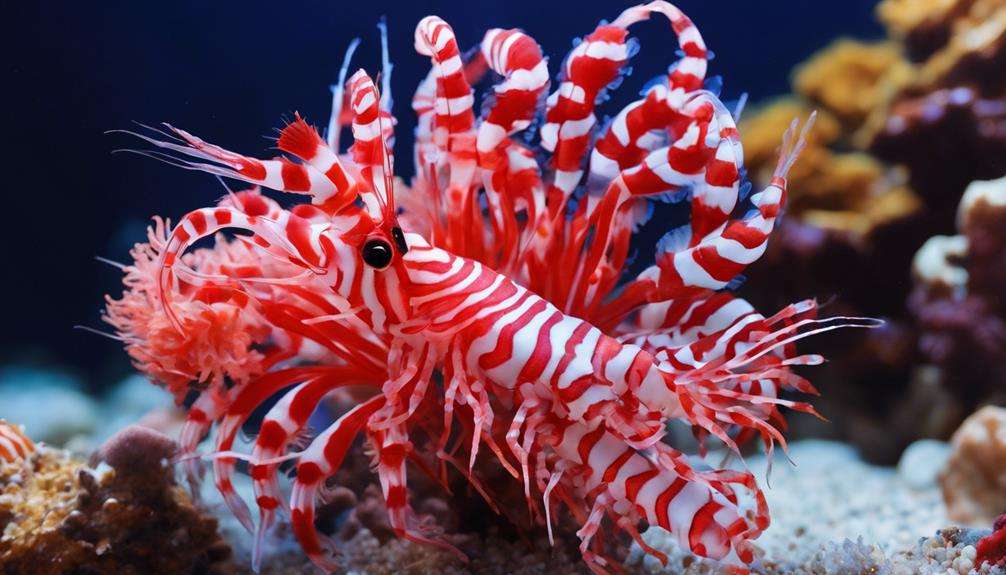
Peppermint shrimp, scientifically known as Lysmata wurdemanni, exhibit fascinating behavior in saltwater aquariums. These unique invertebrates are sought after for their adeptness at controlling Aiptasia anemones, showcasing their practical value in reef tank maintenance.
Understanding their behavior, tank compatibility, and feeding habits is pivotal for providing top-notch care for these striking red and white striped crustaceans.
Peppermint Shrimp Behavior
Observing the behavior of the unique Peppermint Shrimp in a marine aquarium setting reveals fascinating interactions within the ecosystem. These shrimp are social creatures, often seen in small groups where they establish hierarchies through subtle displays of dominance.
When it comes to feeding habits, Peppermint Shrimp are scavengers, eagerly consuming detritus, leftover food, and algae. They also exhibit a unique behavior of cleaning other fish by removing parasites and dead tissue, contributing to the overall health of the tank.
In relation to reproductive behavior, Peppermint Shrimp reproduce through internal fertilization, with females carrying eggs until they hatch into larvae. Understanding these aspects of Peppermint Shrimp behavior can enhance your appreciation for these intriguing marine invertebrates.
Tank Compatibility Tips
In understanding the tank compatibility of unique Peppermint Shrimp, it's important to take into account their peaceful nature and ability to coexist with various tank mates, including corals and small fish.
To enhance their breeding success, provide hiding spots in the tank decor where the shrimp can molt safely. Peppermint shrimp are efficient in controlling Aiptasia anemones, contributing to tank maintenance.
Maintaining vital water parameters such as temperature, salinity, and pH is essential for their well-being. When selecting tank mates, consider peaceful species that won't outcompete the shrimp for food.
Regular tank maintenance and providing ample food sources are key to keeping these shrimp healthy and thriving in your aquarium setup.
Feeding Requirements Explained
For best health and nutrition of your unique Peppermint Shrimp, a varied diet rich in essential nutrients is essential. These shrimp have specific nutritional requirements to thrive in captivity. Peppermint shrimp are omnivores with scavenging feeding habits, consuming detritus, algae, and small invertebrates in the aquarium.
To meet their dietary needs, offer a diverse diet consisting of commercial shrimp food, algae sheets, and occasional meaty foods like brine shrimp or mysis shrimp. Ensuring a well-rounded diet will support their overall health and vitality.
Additionally, providing a well-established aquarium with stable water parameters and plenty of hiding spots will help create an ideal environment for your peppermint shrimp to flourish.
Mesmerizing Sea Apple
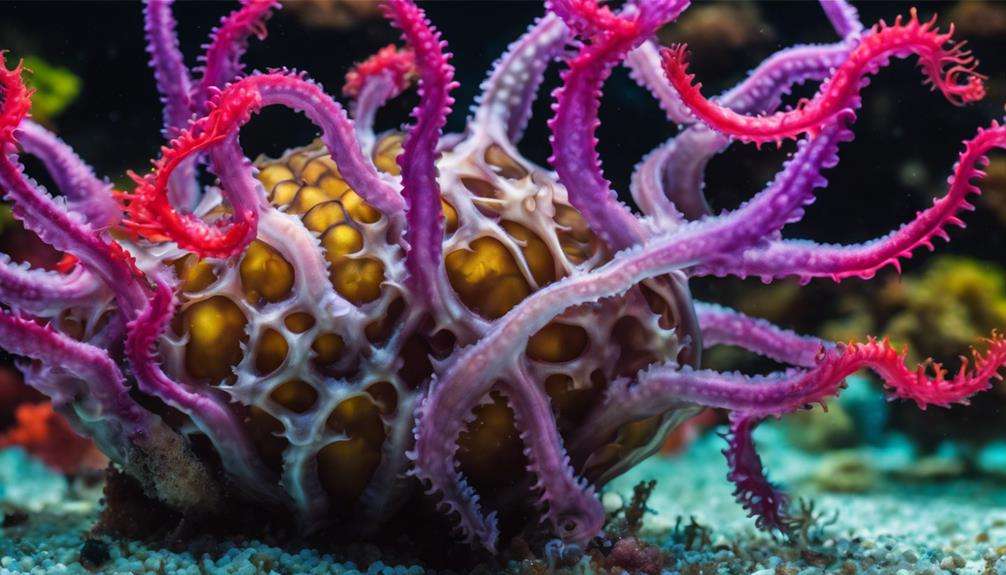
Mesmerizing Sea Apples, with their vibrant colors and unique appearance, are brightly colored marine invertebrates commonly found in reef aquariums. These filter feeders primarily consume phytoplankton and other tiny particles from the water, making them an intriguing addition to your tank. When caring for Sea Apples, it's important to maintain stable water conditions in a well-established aquarium due to their sensitivity. These invertebrates can reach sizes of 6-8 inches and have a moderate growth rate, requiring adequate space to thrive.
However, it's important to handle Sea Apples with caution as they can release toxins when stressed, posing a risk to other tank inhabitants. Proper acclimatization and a peaceful environment are necessary for their well-being. When it comes to feeding, providing a varied diet rich in phytoplankton and other suitable food sources will help maintain the health and vibrancy of these mesmerizing creatures in your saltwater aquarium.
Intriguing Chocolate Chip Starfish
The Chocolate Chip Starfish, known scientifically as Protoreaster nodosus, showcases a striking appearance with distinct chocolate-colored tubercles on its cream-colored body. These fascinating creatures have unique breeding habits, with females releasing eggs into the water where they're fertilized externally by males. The larvae then go through several stages before settling on the ocean floor and developing into adult starfish.
When it comes to lifespan expectations, Chocolate Chip Starfish have been known to live up to 10 years in the wild, and with proper care in captivity, they can reach a similar age. It's important to provide them with a spacious tank of at least 50 gallons to make sure they've enough room to move around and explore. Additionally, maintaining stable water conditions with appropriate temperature, salinity, and pH levels is critical for their well-being.
Exotic Harlequin Ghost Pipefish
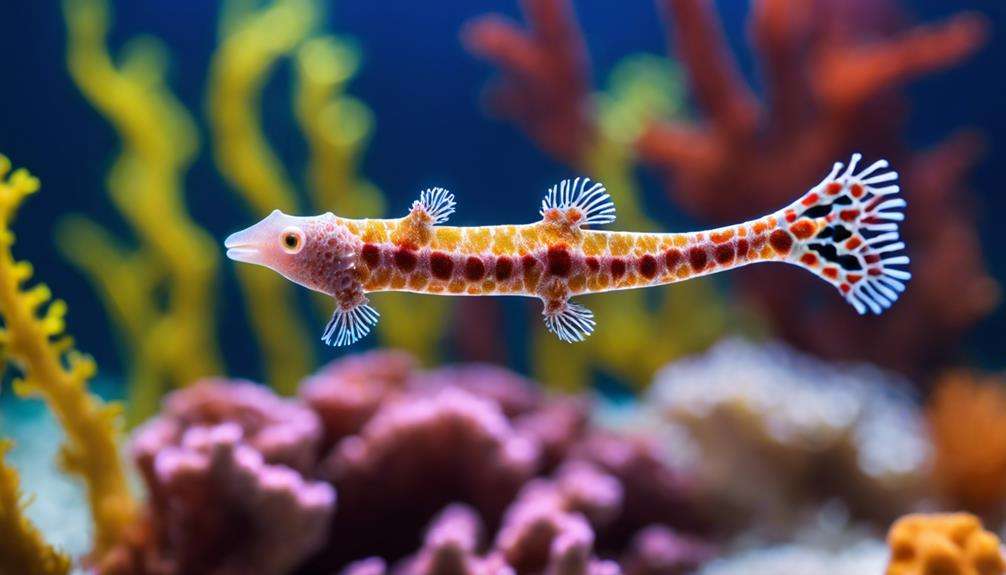
Harlequin Ghost Pipefish, members of the Solenostomus paradoxus species, inhabit the tropical waters of the Indian and Pacific Oceans, displaying a unique appearance reminiscent of a ghostly leaf or twig. These delicate creatures pose breeding challenges and have specific care requirements. Maintaining stable water parameters, including temperature (around 77-82°F), pH (8.1-8.4), and salinity (1.020-1.025), is essential for their well-being. When setting up their tank, provide ample live rock for hiding spots and simulate their natural habitat with seagrass or artificial plants.
Feeding these pipefish can be tricky as they primarily eat live foods like tiny crustaceans. Offering them enriched live brine shrimp or copepods is vital to meet their nutritional needs. Interestingly, Harlequin Ghost Pipefish exhibit unique behavioral observations, often mimicking the movement of drifting seaweed to blend in with their surroundings. Due to their fragility and specific requirements, these captivating pipefish are best suited for experienced aquarists looking to take on the challenge of caring for these mesmerizing creatures.
Enigmatic Pom-Pom Crabs
Pom-Pom Crabs, also known as Boxer Crabs, are intriguing marine crustaceans distinguished by the distinctive, hairy pom-poms they carry. These unique crabs exhibit fascinating defense strategies by utilizing stinging anemones for protection. The anemones, held in the crabs' claws, act as deterrents against predators, showcasing a remarkable adaptation in nature. This crab-anemone relationship goes beyond defense; it's symbiotic in nature. The crabs benefit from the anemones' stinging capabilities while providing them with mobility and access to food, creating a mutually beneficial partnership.
In captivating anemone care, Pom-Pom Crabs are known to meticulously maintain their anemones, ensuring they're healthy and effective for defense. Found primarily in the tropical waters of the Indo-Pacific region, these crabs are commonly spotted in coral reefs and sandy bottoms. Their popularity in saltwater aquariums stems from their captivating behavior and striking appearance, making them a desirable choice for marine enthusiasts seeking unique and enigmatic creatures.
Frequently Asked Questions
Can You Keep Saltwater Fish as Pets?
Yes, you can keep saltwater fish as pets. Providing proper nutrition, maintaining the tank, and monitoring for common diseases are essential for their well-being. Understanding their specific requirements and behaviors enhances the experience of owning these enchanting marine creatures.
How Many Saltwater Fish Can You Put in a 30 Gallon Tank?
In a 30-gallon tank, you should aim for 6-10 small saltwater fish, considering adult size, species compatibility, and territorial behavior. Overstocking can harm water quality and fish health, so research each species' needs carefully.
What Fish Can I Put in a 75 Gallon Saltwater Tank?
In a 75-gallon saltwater tank, you can consider popular fish like clownfish, gobies, blennies, and dwarf angelfish. Guarantee proper tank size, compatibility, and research specific needs to create a thriving environment for your fish.
What Is the Easiest Clownfish to Keep?
If you're wondering what the easiest clownfish to keep is, search no more than the Ocellaris Clownfish. With their vibrant colors, peaceful nature, and adaptability, they're perfect for beginner marine hobbyists.
Conclusion
To sum up, the world of exotic saltwater invertebrates offers a fascinating glimpse into the wonders of marine life. From the enchanting Arrow Crabs to the mesmerizing Sea Apple, these unique creatures add vibrancy and diversity to any home aquarium.
By following proper care guidelines and creating a suitable environment, pet owners can enjoy the beauty and intrigue of these stunning species. Explore the depths of the ocean in your own home with these extraordinary creatures.
